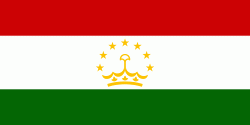Flag of Tajikistan
The national flag of Tajikistan (Парчами Тоҷикистон / Parçami Tojikiston / پَرچَمِ تاجِیکِستان) was adopted in November 1992, replacing the flag of the Tajik Soviet Socialist Republic of 1953. The flag is a horizontal tricolor of red, white and green, with a yellow crown surmounted by an arc of seven stars at the centre. It has a width ratio of 2:3:2. The tricolor preserves the choice of colors in the former Tajik Soviet flag, as well as the 1:2 proportions.
The flag day is celebrated on 24 November, which is the day it was officially adopted.
The flag of Tajikistan is a tricolour of red, white, and green. The red represents the unity of the nation as well as victory and sunrise. The red also serves as symbolism of the former Russian and Soviet eras, the workers, and the warriors who sacrificed their lives to protect the land. The white represents purity, morality, the snow and ice of the mountains, and cotton. The green represents the bountiful generosity of nature, fertile valleys, the religion of Islam, and the celebration of Novruz. Other interpretations of the colours state that the flag symbolically unifies the people of Tajik society, with the red stripe representing the manual labour class, the white stripe representing the intellectual worker class, and the green representing the agricultural class living in Tajikistan's rural or mountainous regions.
While the red and green stripes on the top and bottom are equal in size, the center stripe is one-and-a-half times that of the others.
number seven in Persian mythology, representing perfection and happiness. According to traditional belief, the heavens feature seven mountains and seven orchard gardens with a star shining above each mountain.
The flag day is celebrated on 24 November, which is the day it was officially adopted.
The flag of Tajikistan is a tricolour of red, white, and green. The red represents the unity of the nation as well as victory and sunrise. The red also serves as symbolism of the former Russian and Soviet eras, the workers, and the warriors who sacrificed their lives to protect the land. The white represents purity, morality, the snow and ice of the mountains, and cotton. The green represents the bountiful generosity of nature, fertile valleys, the religion of Islam, and the celebration of Novruz. Other interpretations of the colours state that the flag symbolically unifies the people of Tajik society, with the red stripe representing the manual labour class, the white stripe representing the intellectual worker class, and the green representing the agricultural class living in Tajikistan's rural or mountainous regions.
While the red and green stripes on the top and bottom are equal in size, the center stripe is one-and-a-half times that of the others.
number seven in Persian mythology, representing perfection and happiness. According to traditional belief, the heavens feature seven mountains and seven orchard gardens with a star shining above each mountain.
National flag
Country - Tajikistan
Warning: getimagesize(/Image/Map/MP1220409.gif): failed to open stream: No such file or directory in /home/mapnlee7/public_html/MAPNALL/article.php on line 532
 |
 |
The territory that now constitutes Tajikistan was previously home to several ancient cultures, including the city of Sarazm of the Neolithic and the Bronze Age and was later home to kingdoms ruled by people of different faiths and cultures, including the Oxus civilization, Andronovo culture, Buddhism, Nestorian Christianity, Hinduism, Zoroastrianism, Manichaeism, and Islam. The area has been ruled by numerous empires and dynasties, including the Achaemenid Empire, Sasanian Empire, Hephthalite Empire, Samanid Empire, and Mongol Empire. After being ruled by the Timurid Empire and Khanate of Bukhara, the Timurid Renaissance flourished. The region was later conquered by the Russian Empire and subsequently by the Soviet Union. Within the Soviet Union, the country's modern borders were drawn when it was part of Uzbekistan as an autonomous republic before becoming a full-fledged Soviet republic in 1929.
